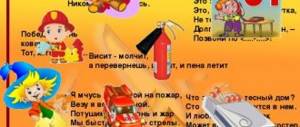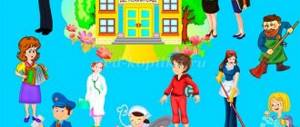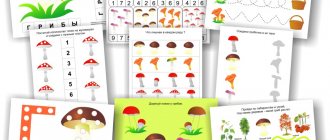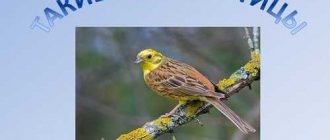Types of walks in the GPA
Organization of activities of an after-school group
Organization of teacher activities in the GPA
Working hours of the extended day group
Forms and methods of activity of an afterschool teacher
1. Recommendations for organizing students’ homework (self-preparation)
1.1. Lessons are carried out in a designated classroom or office, which is equipped with furniture appropriate to the height of the students.
1.2. Start self-preparation no later than 16.00 (while there is a physiological increase in performance).
1.3. Limit the duration of homework: for 2nd grade - 1.5-2 hours; for grades III-IV - 2-2.5 hours.
1.4. Provide children with a choice of order in which to complete homework, recommending starting with a subject of average difficulty for a given student.
1.5. Provide students with the opportunity to take individual breaks upon completion of a certain stage of work, since a regulated break often distracts from independent work and disrupts the train of thought.
1.6. Carry out a warm-up (physical training session) lasting 1-2 minutes as fatigue appears.
1.7. Provide children who have completed assigned lessons earlier than others with the opportunity to spend time pursuing interests (in the playroom, library) until the end of the whole group’s work.
2. Organization of extracurricular activities of the GPD (classes in clubs, participation in various entertainment events, amateur art activities, quiet games, reading, watching TV shows, etc.)
2.1. Educators should plan their activities so that every day, within 1-1.5 hours after completing self-training, children can choose activities for themselves in accordance with their interests and desires. The duration of such classes depends on the age of the students and the type of activity. The duration of classes such as reading, music, drawing, modeling, handicrafts, quiet games is no more than 50 minutes for students in grades II and 1.5 hours for students in grades III-IV with a 5-10 minute break in the middle of classes.
2.2. Collective events, school-wide evenings, concerts, assemblies, debates, visits to theaters, cinema and concert halls, excursions are best organized at the beginning of the week, when students have not yet become tired, and no more than 1-2 times a month.
2.3. Watching TV shows should be done no more than 1-2 times a week with a duration limit of up to 30 minutes; visiting cinemas, exhibitions, museums, theaters - no more than 1-2 times a month.
2.4. It is important to correctly combine types of extracurricular activities throughout the day and rationally distribute them throughout the week. The best combination of activities during the day is physical activity in the air (walking, outdoor and sports games, socially useful work in the school area) before doing homework, followed by activities of an emotional nature (entertainment events, activities in clubs, reading, games, gatherings and etc.).
LiveInternetLiveInternet
nata_tursha
all posts by the author Many parents are faced with the question of how to properly walk with their child so that it is not boring not only for the child, but also for the parents themselves. How to make joint walks with our kids not only interesting, fun and varied, but also educational. Victoria Alekseeva shares her interesting advice and ideas on this issue.
Now many parents complain that it is difficult to get their children outside. If you learn to turn every outing into a holiday, your baby will acquire the wonderful habit of walking a lot, which means he will become stronger and healthier. Walking also stimulates brain development and trains muscles. So whatever you say, walking is very useful. These are the kind of outdoor games you can use in the spring. Arm yourself with ideas and go for a walk.
City against the sky
Look at houses located far away from you, and you will see different silhouettes - rectangular, square, triangular, stepped. Pay special attention to how the outlines of houses look against the sky. When you return home, help your child make a silhouette of the city. Let him draw on dark paper the outlines of the houses he saw on the horizon, cut them out and paste them on a sheet of blue paper. You can stick small yellow squares on the “houses” - windows.
On the outskirts of the city
Be an explorer. Take your child to different areas of the city and take a walk there. If you can’t see the horizon line behind the houses, but you know that you can still see it nearby, go there and admire the view.
Fun walks
If the sun is shining with all its might, and the air is fresh, and you are in the mood to fool around, let your walk be fun, go and dance. Wave your arms and sing something simple like:
Together we walk merrily along the sunny road, and our feet walk very cheerfully and lightly.
Wave your arms higher and lower. Change the rhythm. Add some funny steps or jumps. Keep count and kick your foot every third step. Walk, counting your steps rhythmically. Count by twos, then by tens, and maybe by fives. And when you get bored, march to nursery rhymes.
Sing while you walk
It may be more interesting for your child to walk if you sing along with him as you walk. Notice how the song affects your step. If you sing a march, your step quickens. What happens if you switch to a lullaby? Sing whatever comes to mind.
Clock game
This game can be useful for children who are learning to tell time. Hide some “treasure” in the yard and invite your child to find it. Take a table or wrist clock with you into the yard and tell your little treasure hunter how to determine the direction. Using the numbers on the clock, hint him where to look. For example, if you are both “standing at the number six,” tell your child that the object can be found by taking a few steps towards the number “twelve,” or make it more difficult for him to find it by sending him to “four o’clock” first. With toddlers, you can use the words “hot” and “cold”; “left” and “right”; "forward" and "backward".
How long will it take?
Before you go for a walk, do a deep study of time. Get a toy clock and set its hands to the exact time you leave the house, or you can quickly make a paper clock yourself. (Draw numbers in a circle. And to attach arrows to its center, use a paper clip. In extreme cases, you can get by with a hairpin.)
When you return from a walk, compare the position of the hands on a toy watch and a real one. Calculate how long you walked. Move the hands of the paper clock around the dial until they show the same time as the real clock. This will give the child an idea of how much time has passed. If you do this after every walk, your child will learn that moving the arrows a little means little time, and when the arrow moves more notches, it means you walked longer.
Who will see first
Pick an object—a red car, a newsstand, or a window with flowers—and see who notices it first. With older children, you can make the task more challenging, such as looking for a convertible car, a road sign containing a specific word, or a person with a leather suitcase.
Variations on a theme
When you and your child have been together enough, talked and even sang, try playing the game “Follow the Leader.” The leader announces how you need to move to the agreed place - say, to a corner, to a mailbox, or along the road until a car passes. It may require you to hop on one leg, take giant strides, keep your hand on your head, gallop like a horse, and bend over and touch your toes every five steps. The leader can change the direction and method of movement.
We collect all sorts of things
Take a bag or small box with you on your walks to store your finds. Look around to see if you come across anything that you could bring home and show to the whole family. For example, you may find a shiny pebble, a beautiful leaf, some thick pod, or an even fatter caterpillar. Keep in mind that what fascinates your child may seem like trash to you, but if the find is harmless, allow your child to take it with him.
When you get home, lay out your finds on the floor or table and look at them carefully. Take out a magnifying glass so your child can get a good look at his treasures in an enlarged form. In the evening, let him demonstrate them to the rest of the family. Some children may want to collect a collection of unusual pebbles, leaves, or whatever else they like. Give your child a shoebox to store his collection in.
How far is it?
While walking with your child, select some object not far from you, for example, a fire escape on a house, and count how many steps there are to it. Then choose something else. Compare how different the distance to both objects is, measured in steps. Try to estimate with your child how many steps it will take to approach some close object. For example, it took you twenty steps to get to the mailbox, but now guess what, it will take more or fewer steps to get to the sandbox. You can walk to a place with normal steps, then turn around and see how many fewer steps it takes you if you walk back with giant steps.
Measuring the distance
If you have older children around, take a tape measure with you and show them what a distance of a centimeter, a meter, ten meters looks like. Measure this distance by determining how many steps you need to take to walk one meter. Measure some distances in steps and then do it again with a tape measure to check how accurate you were.
This noisy world
When you walk, listen to all the sounds and noise around you. Help your child learn to distinguish sounds. When going for a walk in a park or forest, listen to the sounds of nature - birds singing, the rustling of leaves, the sound of the wind, barking dogs, the rustling of feet along the paths. Then take a walk in the city and think about the noises and sounds that fire trucks, police cars and ambulances make, the sounds that we hear when we are close to people - someone talking, laughing, some kind of recording or noise receiver Listen to the clanking sound of cans falling into the trash can, the sound of basketballs bouncing on the playground and tennis balls on the court, etc. With older children, you can talk about onomatopoeic words that take sound “captive” - the buzzing of a bee , bell ringing, frog croaking. Try to come up with your own words together to describe the sounds you hear. What would you call the sound a siren makes?
Hot? Cold?
While walking, draw your child's attention to the fact that all objects feel different to the touch. Consider items made from several materials. Touch the things around you and compare your sensations. For example, one hot day, invite your child to touch the ground and then the body of a parked car and compare their temperatures. Do the same on a cold day. Your child will intuitively understand that metal is a good conductor of heat, that dark objects attract the sun's rays, and that the earth retains heat. Describe the different qualities of the objects you touch. Note that the bricks feel hard and rough to the touch. The bark of the tree is also rough, but in a completely different way. Look for objects that are soft or sticky, scratchy or wet.
Excellent environment
Imagine with your child that you are a sanitary inspector and checking the condition of the nearest streets. Discuss the problem of pollution with him, draw his attention to how nice it is to see a clean street, lawn, and what they will look like if people throw garbage everywhere. Walk the streets and rate the cleanliness. Bring a bag with you to collect trash left by various slobs. If you are in the mood, you can sing a simple song, for example:
I don’t pick up trash, I’m not a dung beetle, I’ll pick up all the pieces of paper, I’ll put all the bottles in a bag, I’m not a dung beetle.
If you are a little lucky, you will be able to maintain your child’s enthusiasm until home and inspire him to clean the children’s room.
How much in total?
Pick something on the street to count. For example, show your child a tree, say a poplar. Teach you to recognize it, and then count how many poplars there are on the street you walk along. You can count how many people wearing glasses have passed, how many green cars are parked on your street, or how many shops are in your neighborhood. When you have already counted one thing, move on to counting something else.
Your own garden bed
Together with your baby, dig up and loosen the soil and sow the seeds of plants that grow quickly so that your baby does not lose interest in this activity. Vegetables that quickly sprout include radishes, cucumbers, and zucchini. Even if the harvest is small, it is very interesting to watch the growth of your garden. From flowers you can plant calendula, nasturtium, matthiola - they will bloom in mid-summer.
“Keeping an eye on our neighbors”
See if any of your neighbors are moving. Large boxes, in which things are usually transported, are excellent building material for small children; and, trying to get such a box for your child, under this pretext you can meet new neighbors. Now that the box is yours, make windows and doors in it. Make the hole without cutting off one of the four sides; this cut out part will serve as shutters or door leaves. If the crowbar is already standing, the child can play a variety of games here. games that just come to his mind. In such a house, children will enjoy having a “tea party” or inviting imaginary guests. They can also start decorating their “home.” Allow me; them to paint their house inside or outside. Give the house a number like real houses. If the child wants, let him give the house some beautiful name. Most likely, this idea will captivate the children, they will climb in and out of the windows, and try to climb onto the house. And in the house itself they have a lot to do.
Bird watching
Why don't you and your little one take an interest in what birds are found in your area and learn to recognize them? Buy a book about birds and see what they are like. You can hang pictures of different birds in your kitchen and, when returning from a walk, check which of them you managed to see. Sometimes, depending on your mood, try to compose some simple poems or stories on this topic with your child. If you wish, arrange a bird feeder.
Flying
Instead of just going for a walk, encourage your child to “fly.” Let the baby imagine himself as different flying objects all the way: “I’m an airplane... I’m a butterfly... I’m a mosquito, e-e-e-e!”
Talk to your child about how everyone flies differently. An airplane, for example, has a motor and it makes a loud sound. The butterfly is completely silent, graceful and moves slowly, as if hanging in the air, and the mosquito, emitting a high-pitched piercing sound, rushes in circles until it finds its victim.
How do kites and birds, airships and bees, clouds and cranes fly?
Flying a kite
If you've never flown a kite, we warn you that getting one into the air is more difficult than it seems at first glance. But it's wonderful fun. You need to find a large open space where there are no wires overhead and the child can run around. The best place for this purpose is the bank of a river or lake, or perhaps the sea; a large grassy field is also quite suitable. Wait for a fresh breeze to blow, grab two kites, plenty of string and go have some fun. Start with simple, inexpensive kites. If you are also interested in this activity, it will be interesting for you and your son to read together about how many different types of snakes there are and how incredibly beautiful they are.
Especially for windy weather
Children who are too young to fly a kite can enjoy the wind in an easier way. Buy or cut narrow multi-colored paper ribbons, fifteen to twenty-five centimeters long, and attach them to the loops on the belt of a child’s suit or to the straps of a onesie. Then take sticks with a blunt (safe) end and tie more ribbons to them. Now you're ready to go on a windy ride with a one-man parade - unless you also want to decorate yourself with ribbons.
Fun walks
“Fun” walks can be done in different ways. For example, you can start with the Tin Woodman from the fairy tale “The Wizard of Oz.” (If your child does not yet know this fairy tale, one day on a rainy day or when your child is feeling unwell, read to him stories about the funny inhabitants of a fairy-tale land.) When you go for a walk, show your child how the Tin Woodman with rusty limbs walks, “let the child will also try to be like that. You will have a reason to talk about what joints are. On your next walk, try moving like a rag doll.
What else can you think of? Perhaps you would like to march like soldiers, or walk on your toes like a ballerina, or take giant strides, or walk backwards? Such walks can be funny and fun, and at the same time they give the baby some knowledge, and in addition, strengthen his muscles.
"Blind" walk
While walking with your child in the park, ask if he would like to try to experience the world without seeing it, relying only on touch and smell. If the child is interested, blindfold him, take him by the hand and lead him to a tree, or to some flowers, or to a bush, or to something else that he can touch and smell.
We teach to look and see
Older children who love to draw will find it attractive to spend time with you somewhere outdoors and paint. And it doesn’t matter whether your child creates a masterpiece or not, you will still create a miracle if you awaken in him the ability to observe. The child will begin to notice shadows, the size of objects and their color.
Buy your child and yourself sets of drawing paper and some pencils or paint. It might make sense to invest in two folding chairs. Having purchased everything you need, decide what kind of nature you would like to capture in your drawing. Maybe you like the interesting architecture of the houses near you or the trees in the park, or you want to draw both. Or maybe you’ll like something completely different? For example, you might be attracted to street lights, road signs, animals at the zoo, cars in a parking lot, or an amazing flower in the garden. To begin, agree that you will only spend five minutes drawing. If after five minutes the child has not cooled down to creativity, invite him to work for another five minutes and try to add more details to the drawing. Well, if your child can’t sit still for five minutes, then talk to him about how you need to look carefully and look again in order to notice every detail of what you’re looking at. If your child develops the ability to focus, you will be able to spend more time with him on each drawing.
Bridle for the critic
Remember that your goal is to have fun, not to create masterpieces. Too picky criticism can turn a child away from this activity. On the other hand, you don't need to praise him, otherwise he will stop taking your praise seriously.
Pebble soup
The youngest children have a very developed imagination and even the simplest activity can seem very funny. For example, pebble soup. Give your child a large plastic bowl half filled with water and a wooden spatula. Help him prepare pebble soup. Add seasonings - depending on the time of year - a little grass, a drop of dirt, twigs, leaves, etc. Ask your child what else to add to make a beautiful color. What other leaves and flowers can be put in soup? Every time you add something new, be sure to stir your soup.
Of course, the child must understand that this soup is not intended for people. Do not try it under any circumstances. When it is ready, heat it in the sun and feed the bush with it.
Clouds
Some days are clear, sunny, the sky is blue, and fluffy white clouds float across it, constantly changing shape. If you find yourself outside on such a day, watch the clouds together. Let the baby see objects and creatures familiar to him in the outlines of the clouds: there is an old man with a hooked nose and a shaggy beard, there is a fluffy white bear, and there is ice cream on a plate that is melting, melting, melting... You also tell your child what this or that reminds you of another cloud. Sometimes your impressions will coincide - this is very pleasant!
Now you know what outdoor games in the spring can diversify your walks so that they are memorable for your baby and help him develop at the same time. And they also brought you closer, because for a child it is very important to have live communication with his parents, their direct participation in his life.
Have a nice walk!
Source: website mom is the best teacher
In addition, Victoria Alekseeva came up with and collected for you and me options for excellent activities for the home. The collection is called “101 ideas for activities with your baby ” and includes a sea of various toys - from nursery rhymes and finger games to creative activities. Click on the name of the collection and get it at your disposal absolutely free.
Series of messages “Outdoor Games”:
Part 1 - Giant soap bubbles Part 2 - Entertainment and games for children and adults. Part 3 - FUN AND EDUCATORY WALKS WITH CHILDREN. Part 4 - Outdoor games in the fresh air: Jump rope, Rubber band, Ali Baba (rules) Part 5 - Therapeutic outdoor games for children... Part 7 - Therapeutic games for aggressive children. Part 8 — Card file of physical education lessons for preschool children “All the colors of the rainbow.” Part 1. Part 9 - Card file of physical education lessons for preschool children “All the colors of the rainbow.” Part 2.





